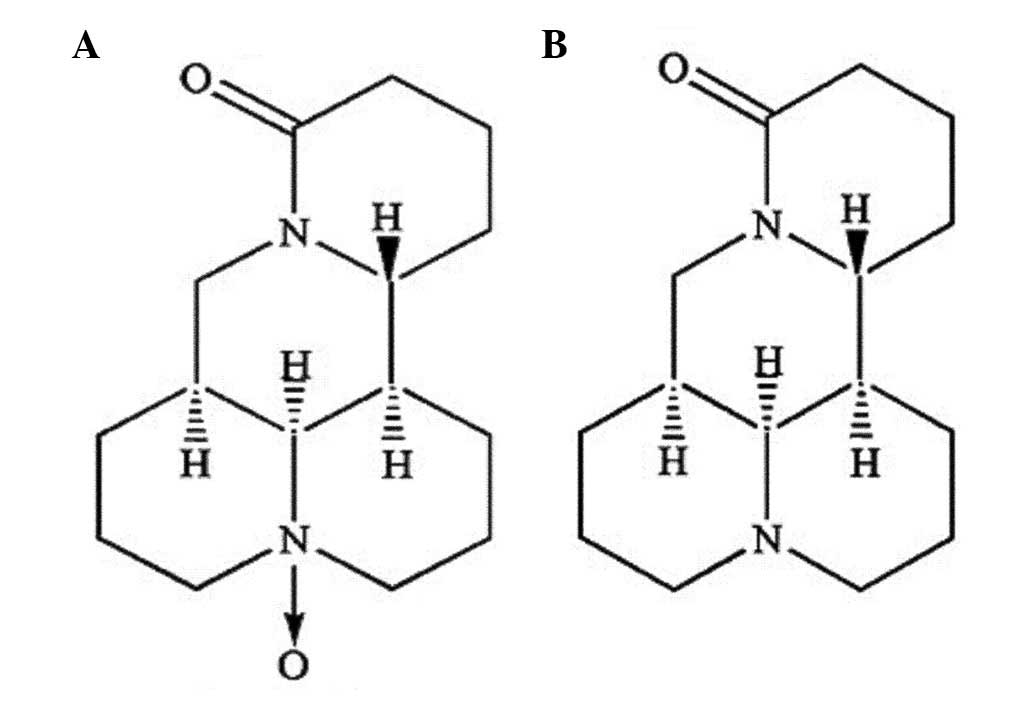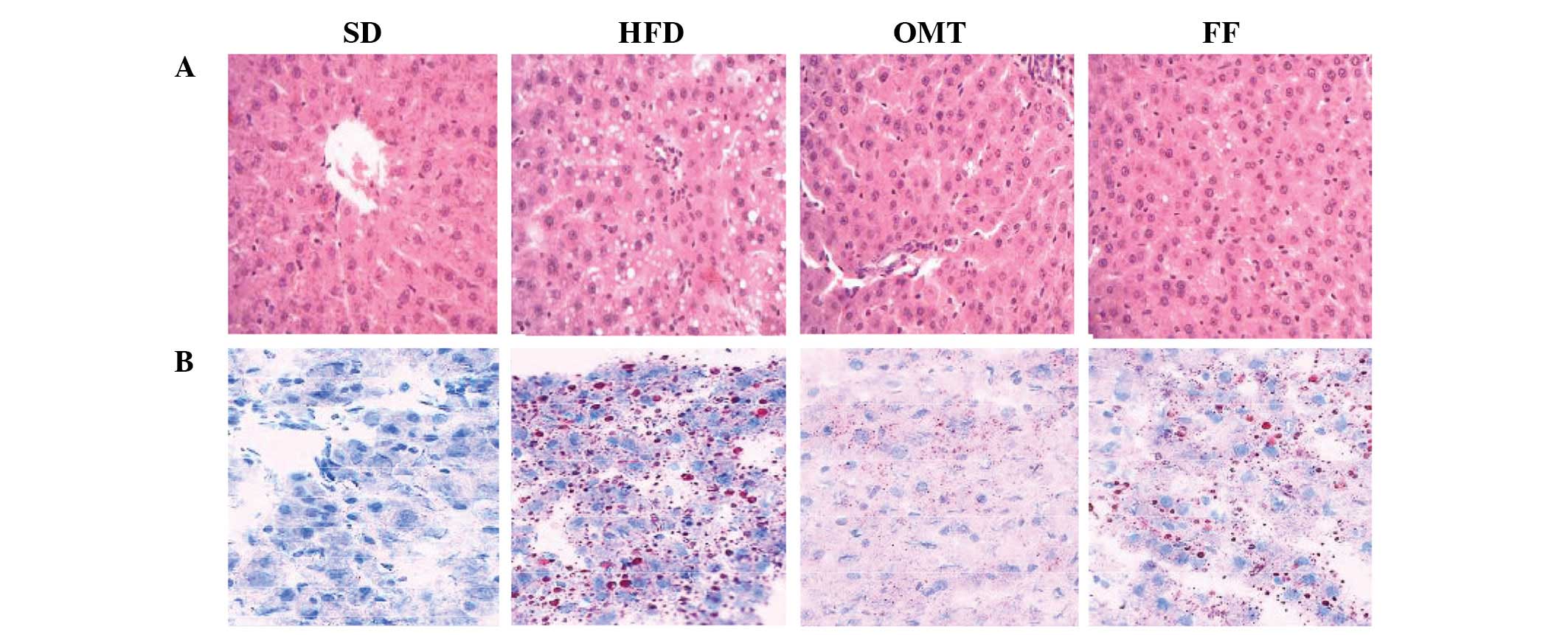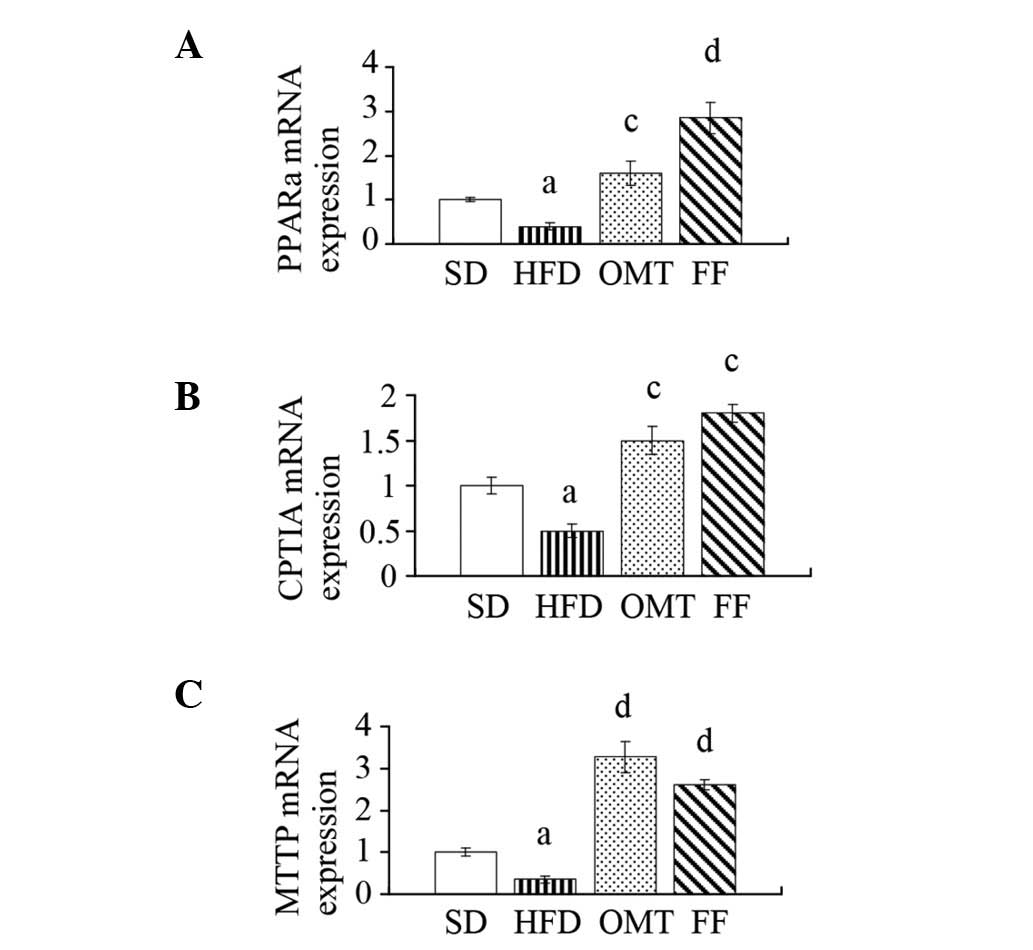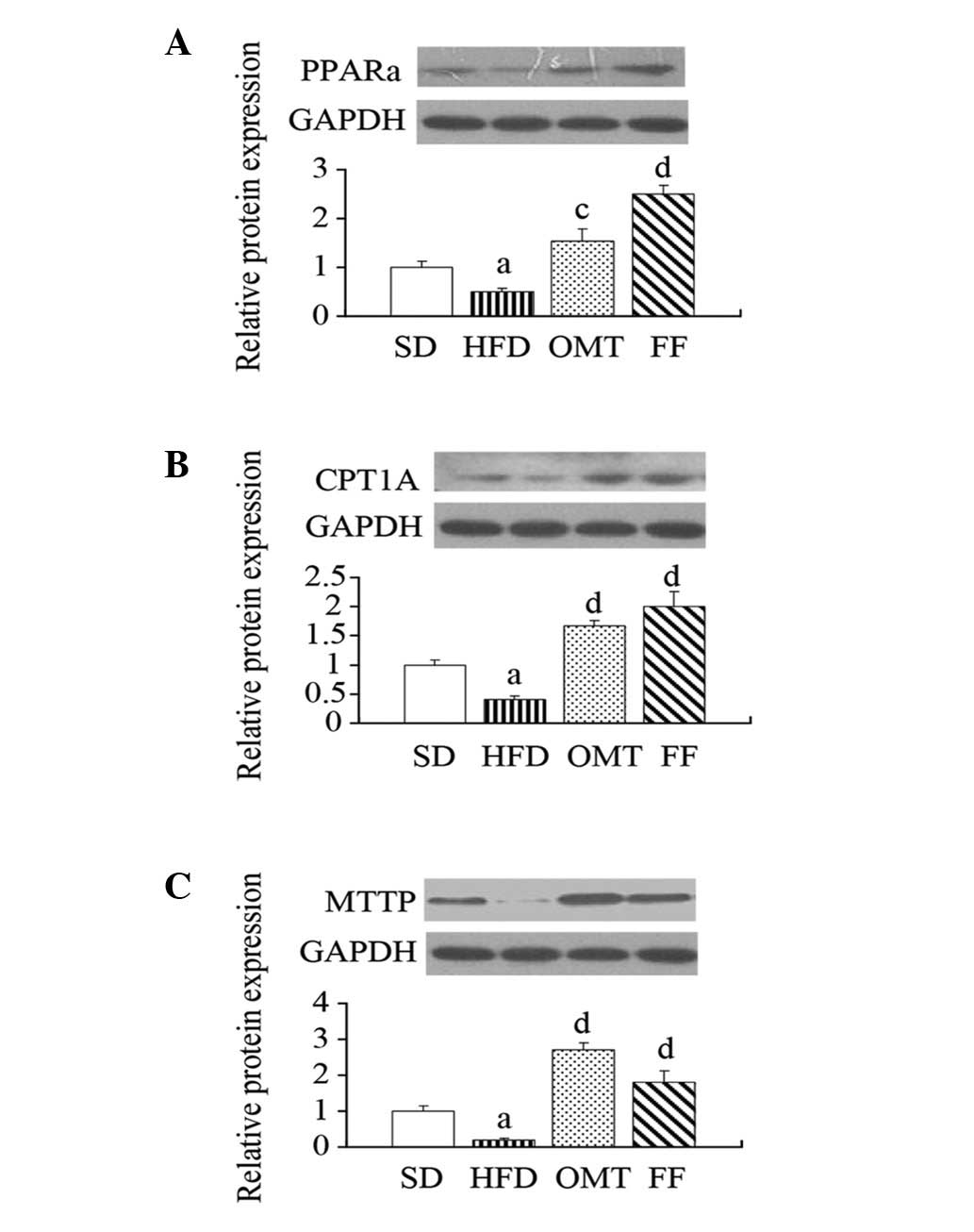|
1
|
Tiniakos DG, Vos MB and Brunt EM:
Nonalcoholic fatty liver disease: pathology and pathogenesis. Annu
Rev Pathol. 5:145–171. 2010. View Article : Google Scholar : PubMed/NCBI
|
|
2
|
Sheng L, Cho KW, Zhou Y, et al: Lipocalin
13 protein protects against hepatic steatosis by both inhibiting
lipogenesis and stimulating fatty acid β-oxidation. J Biol Chem.
286:38128–38135. 2011.PubMed/NCBI
|
|
3
|
Utzschneider KM and Kahn SE: Review: The
role of insulin resistance in nonalcoholic fatty liver disease. J
Clin Endocrinol Metab. 91:4753–4761. 2006. View Article : Google Scholar : PubMed/NCBI
|
|
4
|
Fabbrini E, Mohammed BS, Magkos F,
Korenblat KM, Patterson BW and Klein S: Alterations in adipose
tissue and hepatic lipid kinetics in obese men and women with
nonalcoholic fatty liver disease. Gastroenterology. 134:424–431.
2008. View Article : Google Scholar : PubMed/NCBI
|
|
5
|
Smith BW and Adams LA: Non-alcoholic fatty
liver disease. Crit Rev Clin Lab Sci. 48:97–113. 2011. View Article : Google Scholar : PubMed/NCBI
|
|
6
|
Gaemers IC, Stallen JM, Kunne C, et al:
Lipotoxicity and steatohepatitis in an overfed mouse model for
non-alcoholic fatty liver disease. Biochim Biophys Acta.
1812:447–458. 2011. View Article : Google Scholar : PubMed/NCBI
|
|
7
|
Kersten S, Desvergne B and Wahli W: Roles
of PPARs in health and disease. Nature. 405:421–424. 2000.
View Article : Google Scholar : PubMed/NCBI
|
|
8
|
Améen C, Edvardsson U, Ljungberg A, et al:
Activation of peroxisome proliferator-activated receptor alpha
increases the expression and activity of microsomal triglyceride
transfer protein in the liver. J Biol Chem. 280:1224–1229.
2005.
|
|
9
|
Ye JM, Doyle PJ, Iglesias MA, Watson DG,
Cooney GJ and Kraegen EW: Peroxisome proliferator-activated
receptor (PPAR)-alpha activation lowers muscle lipids and improves
insulin sensitivity in high fat-fed rats: comparison with
PPAR-gamma activation. Diabetes. 50:411–417. 2001. View Article : Google Scholar
|
|
10
|
Seo YS, Kim JH, Jo NY, et al: PPAR
agonists treatment is effective in a nonalcoholic fatty liver
disease animal model by modulating fatty-acid metabolic enzymes. J
Gastroenterol Hepatol. 23:102–109. 2008.PubMed/NCBI
|
|
11
|
Cui X, Wang Y, Kokudo N, Fang D and Tang
W: Traditional Chinese medicine and related active compounds
against hepatitis B virus infection. Biosci Trends. 4:39–47.
2010.PubMed/NCBI
|
|
12
|
Cao YG, Jing S, Li L, et al:
Antiarrhythmic effects and ionic mechanisms of oxymatrine from
Sophora flavescens. Phytother Res. 24:1844–1849. 2010. View Article : Google Scholar : PubMed/NCBI
|
|
13
|
Deng ZY, Li J, Jin Y, Chen XL and Lü XW:
Effect of oxymatrine on the p38 mitogen-activated protein kinases
signalling pathway in rats with CCl4 induced hepatic fibrosis. Chin
Med J (Engl). 122:1449–1454. 2009.PubMed/NCBI
|
|
14
|
Zeng XY, Zhou X, Xu J, et al: Screening
for the efficacy on lipid accumulation in 3T3-L1 cells is an
effective tool for the identification of new anti-diabetic
compounds. Biochem Pharmacol. 84:830–837. 2012. View Article : Google Scholar : PubMed/NCBI
|
|
15
|
Yuan LJ, Lu X, Wang J, Zheng TZ, Qu SY and
Zhang XY: Effects of matrine on weight, serum lipids and
anti-oxidative capacity in high-fatted rats. Lishizhen Medicine and
Materia Medica Research. 9:2062–2064. 2008.
|
|
16
|
Zhang HF, Shi LJ, Song GY, et al:
Protective effects of matrine against progression of high-fructose
diet-induced steatohepatitis by enhancing antioxidant and
anti-inflammatory defences involving Nrf2 translocation. Food Chem
Toxicol. 55:70–77. 2013. View Article : Google Scholar
|
|
17
|
Xing Y, Yan F, Liu Y, Liu Y and Zhao Y:
Matrine inhibits 3T3-L1 preadipocyte differentiation associated
with suppression of ERK1/2 phosphorylation. Biochem Biophys Res
Commun. 396:691–695. 2010. View Article : Google Scholar : PubMed/NCBI
|
|
18
|
Thorburn AW, Storlien LH, Jenkins AB,
Khouri S and Kraegen EW: Fructose-induced in vivo insulin
resistance and elevated plasma triglyceride levels in rats. Am J
Clin Nutr. 49:1155–1163. 1989.PubMed/NCBI
|
|
19
|
Ren LP, Chan SM, Zeng XY, et al: Differing
endoplasmic reticulum stress response to excess lipogenesis versus
lipid oversupply in relation to hepatic steatosis and insulin
resistance. PLoS One. 7:e308162012. View Article : Google Scholar
|
|
20
|
Kraegen EW, James DE, Bennett SP and
Chisholm DJ: In vivo insulin sensitivity in the rat determined by
euglycemic clamp. Am J Physiol. 245:E1–E7. 1983.PubMed/NCBI
|
|
21
|
Donnelly KL, Smith CI, Schwarzenberg SJ,
Jessurun J, Boldt MD and Parks EJ: Sources of fatty acids stored in
liver and secreted via lipoproteins in patients with nonalcoholic
fatty liver disease. J Clin Invest. 115:1343–1351. 2005. View Article : Google Scholar : PubMed/NCBI
|
|
22
|
Postic C and Girard J: Contribution of de
novo fatty acid synthesis to hepatic steatosis and insulin
resistance: lessons from genetically engineered mice. J Clin
Invest. 118:829–838. 2008. View
Article : Google Scholar : PubMed/NCBI
|
|
23
|
Chou CJ, Haluzik M, Gregory C, et al:
WY14, 643, a peroxisome proliferator-activated receptor alpha
(PPARalpha) agonist, improves hepatic and muscle steatosis and
reverses insulin resistance in lipoatrophic A-ZIP/F-1 mice. J Biol
Chem. 277:24484–24489. 2002. View Article : Google Scholar
|
|
24
|
Ip E, Farrell GC, Robertson G, Hall P,
Kirsch R and Leclercq I: Central role of PPARalpha-dependent
hepatic lipid turnover in dietary steatohepatitis in mice.
Hepatology. 38:123–132. 2003. View Article : Google Scholar : PubMed/NCBI
|
|
25
|
Kohjima M, Enjoji M, Higuchi N, et al:
Re-evaluation of fatty acid metabolism-related gene expression in
nonalcoholic fatty liver disease. Int J Mol Med. 20:351–358.
2007.PubMed/NCBI
|
|
26
|
Stefanovic-Racic M, Perdomo G, Mantell BS,
Sipula IJ, Brown NF and O’Doherty RM: A moderate increase in
carnitine palmitoyltransferase 1a activity is sufficient to
substantially reduce hepatic triglyceride levels. Am J Physiol
Endocrinol Metab. 294:E969–E977. 2008. View Article : Google Scholar
|
|
27
|
Wetterau JR and Zilversmit DB: A
triglyceride and cholesteryl ester transfer protein associated with
liver microsomes. J Biol Chem. 259:10863–10866. 1984.PubMed/NCBI
|
|
28
|
Stefano JT, de Oliveira CP,
Corrêa-Giannella ML, et al: Nonalcoholic steatohepatitis (NASH) in
ob/ob mice treated with yo jyo hen shi ko (YHK): effects on
peroxisome proliferator-activated receptors (PPARs) and microsomal
triglyceride transfer protein (MTP). Dig Dis Sci. 52:3448–3454.
2007. View Article : Google Scholar
|
|
29
|
Chen Z, Newberry EP, Norris JY, et al:
ApoB100 is required for increased VLDL-triglyceride secretion by
microsomal triglyceride transfer protein in ob/ob mice. J Lipid
Res. 49:2013–2022. 2008. View Article : Google Scholar : PubMed/NCBI
|


















